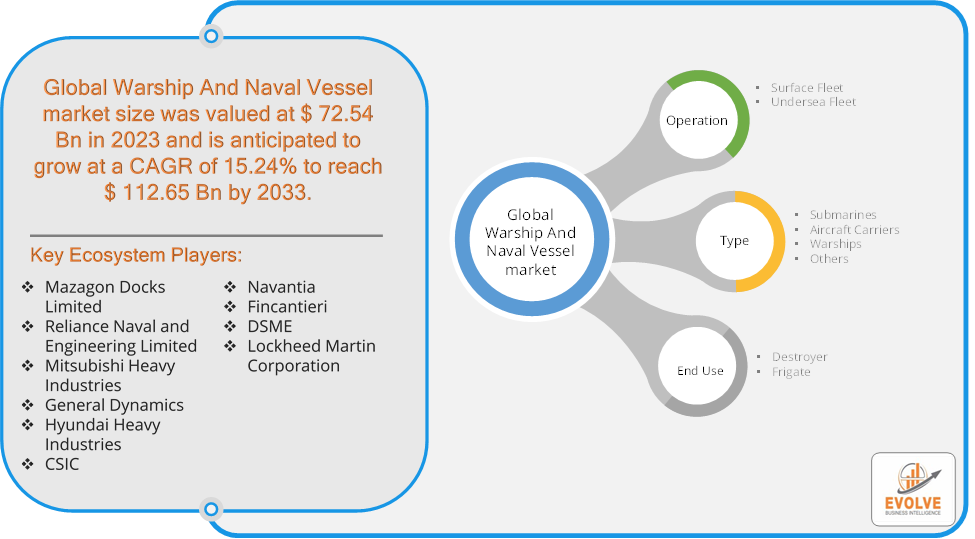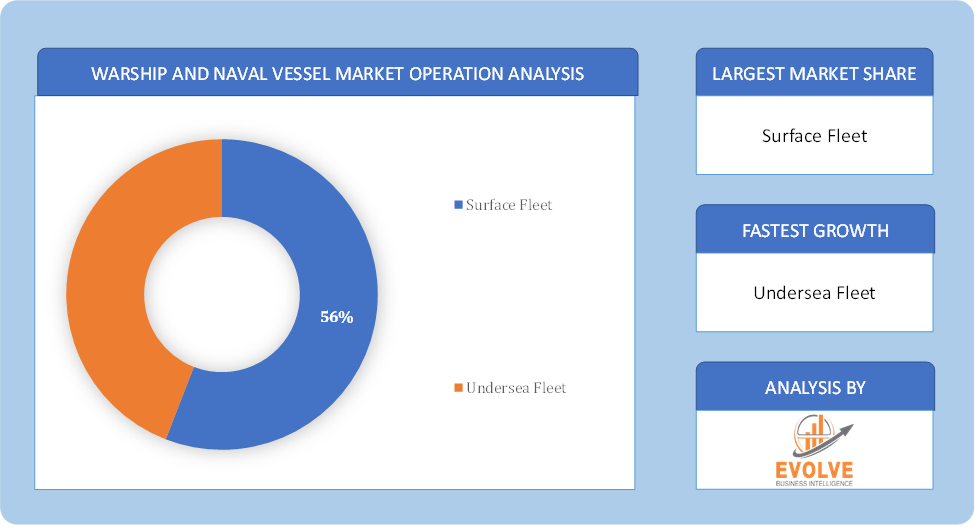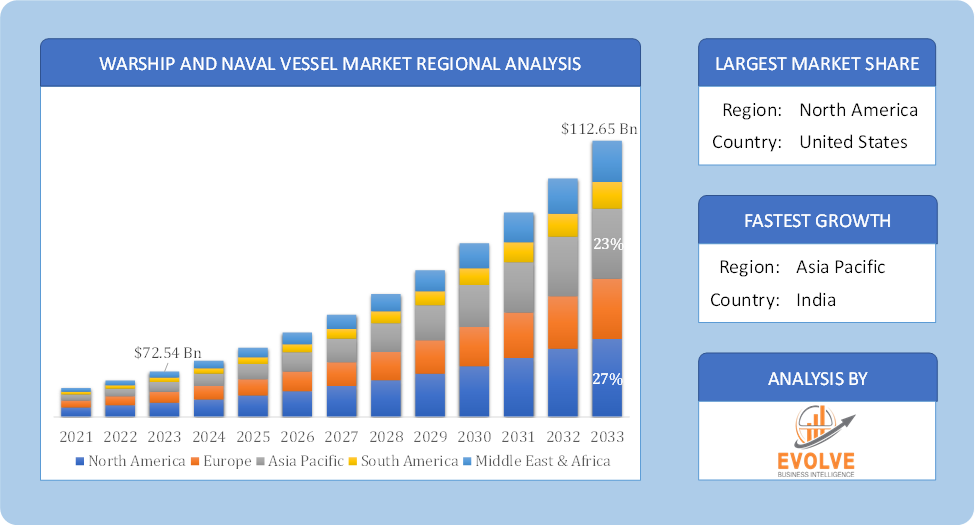Warship And Naval Vessel market Overview
The Warship And Naval Vessel market Size is expected to reach USD 112.65 Billion by 2033. The Warship And Naval Vessel market industry size accounted for USD 72.54 Billion in 2023 and is expected to expand at a compound annual growth rate (CAGR) of 15.24% from 2023 to 2033. The Warship and Naval Vessel Market refers to the sector involved in the design, construction, maintenance, and sale of various types of military and naval ships. These vessels are crucial for a nation’s defense, maritime security, and economic interests.
The market involves various stages including research and development, procurement, manufacturing, maintenance, and modernization of these vessels. Factors influencing the market include defense budgets, geopolitical tensions, technological advancements, and naval strategies of different countries.
Global Warship And Naval Vessel market Synopsis
 COVID-19 Impact Analysis
COVID-19 Impact Analysis
The COVID-19 pandemic had several impacts on the Warship and Naval Vessel Market. The pandemic caused significant disruptions in global supply chains, affecting the availability and delivery of key components and materials needed for the construction and maintenance of naval vessels. The pandemic affected naval operations and training, as restrictions on movement and social distancing measures impacted the ability to conduct exercises, training, and deployments. There was an increased emphasis on health and safety protocols for naval personnel and shipbuilders, including measures to prevent the spread of the virus on ships and in shipyards. The pandemic accelerated the adoption of digital and remote technologies, including virtual meetings, remote monitoring, and digital simulations, to overcome physical limitations and ensure continuity in naval operations and shipbuilding activities. Some nations reassessed their defense priorities in light of the pandemic, focusing on areas such as maritime security and humanitarian assistance, which could influence future naval vessel procurement and development strategies.
Warship And Naval Vessel market Dynamics
The major factors that have impacted the growth of Warship And Naval Vessel market are as follows:
Drivers:
Ø Technological Advancements
Innovations in naval technology, such as advanced weaponry, stealth capabilities, and improved propulsion systems, drive the development and procurement of more advanced and capable naval vessels. Many countries are engaged in modernization programs to replace aging fleets with newer, more capable vessels. This drive for modernization fuels demand for advanced warships and naval vessels. Countries expanding their naval forces to assert their presence or increase their maritime capabilities contribute to growth in the warship and naval vessel market.
Restraint:
- Perception of High Costs and Technological Complexity
The development, construction, and maintenance of naval vessels are highly expensive. Budget constraints and economic downturns can limit the ability of governments to invest in new naval platforms or modernize existing fleets. The increasing complexity of modern naval vessels, including advanced weapon systems and integrated technologies, can pose challenges in terms of design, construction, and maintenance. The high cost and logistical challenges associated with the maintenance and upgrading of existing naval vessels can deter investment in new acquisitions.
Opportunity:
⮚ Increased Maritime Security
Rising concerns about maritime security, including threats from piracy, smuggling, and territorial disputes, drive demand for advanced naval vessels capable of enhancing maritime security operations. Investments in naval base infrastructure and support facilities, such as dry docks and repair yards, create opportunities for companies involved in the construction and maintenance of these facilities. Growing emphasis on environmental sustainability and energy efficiency in naval vessels creates opportunities for developing eco-friendly and fuel-efficient designs.
Warship And Naval Vessel market Segment Overview
 By Operation
By Operation
Based on Operation, the market is segmented based on Surface Fleet and Undersea Fleet. The Surface Fleet segment dominant the market. Many countries are increasing their defense budgets to modernize and expand their naval capabilities, with significant investments in new surface vessels. Surface fleets are critical for maintaining maritime security, ensuring freedom of navigation, and protecting national interests in international waters.
By Type
Based on Type, the market segment has been divided into Submarines, Aircraft Carriers, Warships and Others. The Warships segment dominant the market. Many navies are undertaking modernization programs to replace aging fleets with more advanced and capable warships. The need to protect maritime trade routes, exclusive economic zones (EEZs), and national interests in international waters boosts demand for warships.
By End Use
Based on End Use, the market segment has been divided into Destroyer and Frigate. The Destroyer segment dominant the market. A destroyer is a type of naval vessel that is designed for high-speed operations, long endurance, and multi-mission capabilities. Basically, destroyers are smaller than cruisers and battleships but larger than frigates and corvettes. Destroyers are known for their versatility and firepower. Thus, making them a crucial component of modern naval vessels. The main role of a destroyer is support to other larger ships and to provide protection, such as aircraft carriers or amphibious assault ships.
Global Warship And Naval Vessel market Regional Analysis
Based on region, the global Warship And Naval Vessel market has been divided into North America, Europe, Asia-Pacific, the Middle East & Africa, and Latin America. North America is projected to dominate the use of the Warship And Naval Vessel market followed by the Asia-Pacific and Europe regions.
 Warship And Naval Vessel North America Market
Warship And Naval Vessel North America Market
North America holds a dominant position in the Warship And Naval Vessel market. In North America region, the U.S. is the largest and most advanced naval market globally, with a substantial defense budget allocated to naval capabilities. Canada is focused on modernizing its naval fleet and enhancing maritime security and defense capabilities.
Warship And Naval Vessel Asia-Pacific Market
The Asia-Pacific region has indeed emerged as the fastest-growing market for the Warship And Naval Vessel market industry. In Asia-Pacific region, China is rapidly expanding its naval capabilities with a focus on aircraft carriers, destroyers, and submarines. China is also investing heavily in naval modernization and advanced technologies and also India is investing in expanding and modernizing its naval fleet, including aircraft carriers, destroyers, and submarines, as part of its strategic and defense goals.
Competitive Landscape
The global Warship And Naval Vessel market is highly competitive, with numerous players offering a wide range of software solutions. The competitive landscape is characterized by the presence of established companies, as well as emerging startups and niche players. To increase their market position and attract a wide consumer base, the businesses are employing various strategies, such as product launches, and strategic alliances.
Prominent Players:
- Mazagon Docks Limited
- Reliance Naval and Engineering Limited
- Mitsubishi Heavy Industries
- General Dynamics
- Hyundai Heavy Industries
- CSIC
- Navantia
- Fincantieri
- DSME
- Lockheed Martin Corporation
Scope of the Report
Global Warship And Naval Vessel market, by Operation
- Surface Fleet
- Undersea Fleet
Global Warship And Naval Vessel market, by Type
- Submarines
- Aircraft Carriers
- Warships
- Others
Global Warship And Naval Vessel market, by End Use
- Destroyer
- Frigate
Global Warship And Naval Vessel market, by Region
- North America
- US
- Canada
- Mexico
- Europe
- UK
- Germany
- France
- Italy
- Spain
- Benelux
- Nordic
- Rest of Europe
- Asia Pacific
- China
- Japan
- South Korea
- Indonesia
- Austalia
- Malaysia
- India
- Rest of Asia Pacific
- South America
- Brazil
- Argentina
- Rest of South America
- Middle East & Africa
- Saudi Arabia
- UAE
- Egypt
- South Africa
- Rest of Middle East & Africa
| Parameters | Indicators |
|---|---|
| Market Size | 2033: USD 112.65 Billion |
| CAGR (2023-2033) | 15.24% |
| Base year | 2022 |
| Forecast Period | 2023-2033 |
| Historical Data | 2021 (2017 to 2020 On Demand) |
| Report Coverage | Revenue Forecast, Competitive Landscape, Growth Factors, and Trends |
| Key Segmentations | Operation, Type, End Use |
| Geographies Covered | North America, Europe, Asia-Pacific, South America, Middle East, Africa |
| Key Vendors | Mazagon Docks Limited, Reliance Naval and Engineering Limited, Mitsubishi Heavy Industries, General Dynamics, Hyundai Heavy Industries, CSIC, Navantia, Fincantieri, DSME and Lockheed Martin Corporation. |
| Key Market Opportunities | · Increased Maritime Security · Naval Base and Infrastructure Development |
| Key Market Drivers | · Technological Advancements · Naval Modernization Programs |
REPORT CONTENT BRIEF:
- High-level analysis of the current and future Warship And Naval Vessel market trends and opportunities
- Detailed analysis of current market drivers, restraining factors, and opportunities in the future
- Warship And Naval Vessel market historical market size for the year 2021, and forecast from 2023 to 2033
- Warship And Naval Vessel market share analysis at each product level
- Competitor analysis with detailed insight into its product segment, Government & Defense strength, and strategies adopted.
- Identifies key strategies adopted including product launches and developments, mergers and acquisitions, joint ventures, collaborations, and partnerships as well as funding taken and investment done, among others.
- To identify and understand the various factors involved in the global Warship And Naval Vessel market affected by the pandemic
- To provide a detailed insight into the major companies operating in the market. The profiling will include the Government & Defense health of the company’s past 2-3 years with segmental and regional revenue breakup, product offering, recent developments, SWOT analysis, and key strategies.


 Warship And Naval Vessel North America Market
Warship And Naval Vessel North America Market

